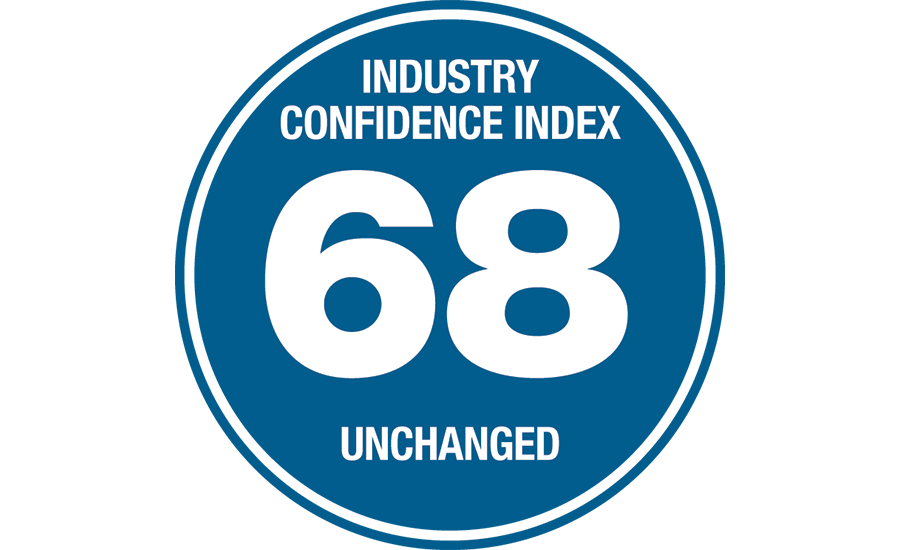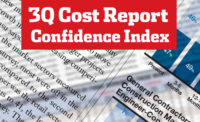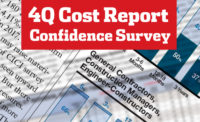Construction is a cyclical industry. Industry executives enduring recessions console themselves with the knowledge that, sooner or later, the bad times will pass. With a few notable exceptions, they are enjoying a growing market now. But those executives are looking ahead with concern.
|
Related Link:
4th Quarterly Cost Report |
The ENR Construction Industry Confidence Index for the fourth quarter shows that, of the 253 executives of large construction and design firms responding to the survey, most believe the market is nearing its peak and may soon level off or decline. The CICI index was 68 on a scale of 100 in the fourth-quarter survey, the same as in the third quarter and down 10 points from its high point in the first quarter.
The CICI measures executive sentiment about the current market and reflects the respondents’ views on where it will be in the next three to six months and over a 12- to 18-month period. The index is based on responses to surveys sent out to more than 6,000 U.S. firms on ENR’s lists of leading general contractors, subcontractors and design firms. The survey was conducted from Nov. 12 through Dec. 7.
Executives say most market sectors are currently in a growth mode, but they are beginning to believe that the market is showing signs of stabilizing. This belief follows the trend reflected in the CICI throughout the year as execs are growing more cautious in their outlook.
For example, 43% of those surveyed say the market is growing, compared to 49% in the third quarter, while 48% now say the market has stabilized. Most execs believe the market will continue to grow in 2016, but at a slower rate than in 2015. The soon-to-be-released results of the latest Confindex survey from the Construction Financial Management Association, Princeton, N.J. also indicate a sense of caution. CFMA each quarter polls 200 CFOs from general and civil contractors and subcontractors. While a Confindex rating of 100 indicates a stable market, higher ratings suggest growth is expected. “Our Confindex fell to 128 in this quarter, down from 131 [on a scale of 200] from the third quarter,” says Stuart Binstock, CEO of CFMA.
CFMA Sees Uncertainty Ahead
Binstock goes on to note that the current “business conditions” component of the Confindex dropped nine points this quarter, to 136, and the year-ahead outlook component fell to 122 from 125. “This could be an indication that the market is pretty good right now and the only place to go is down,” he says.
There are real fears among many CFOs that business conditions in 2016 will hit contractors’ bottom lines, says Anirban Basu, CEO of economic consultant Sage Policy Group Inc., Baltimore, and CFMA economic adviser. He notes that staffing shortages may cause pressure on compensation and that many fear materials prices, which have been stable for five years, may finally begin to increase.
Basu also says there are troubling factors outside the industry that could affect markets in 2016. “Many CFMA members say health-care costs are rising more quickly than in the past, and the uncertainties over the upcoming presidential election, troubling events out of Europe and a wobbly stock market have many of our members worried,” he says.
Paying the Piper
As part of the CICI survey, ENR asked respondents about their firms’ plans regarding increasing staff in 2016. Of the 246 executives answering this question, 72.0% said their firms are planning to add staff, while 18.3% said they were not seeking to do so. The most sought-after positions mentioned by the survey respondents were project managers, engineers, craft labor and estimators.
The CICI survey also asked about firms’ plans to increase salaries in 2016. The average anticipated raise will be 4.67% for the 224 firms that provided raise levels. Eight firms planned to raise salaries by 15% to 30%. Even discounting these firms, the average raise among survey respondents was 4.14%. Only four firms said they had no plans at this time to give raises in 2016.
In the CICI survey, execs also were asked to assess current and future market prospects in any of the 15 survey market sectors in which they now work. Respondents reported a broad softening in market-sector growth. The CICI ratings fell in eight of the 15 markets surveyed and were flat in three others.
The biggest decline was in the industrial and manufacturing sector, which was down eight points, to a CICI rating of 57. Also down were the retail sector—off four points, to 59—and multi-unit residential, which also was down four points, to a still-strong 70 rating. “Everyone knows multi-unit residential will decline. They just don’t know when,” says Binstock.
The health-care sector was up five points, to 72. Another gainer was transportation, which was up three points, to 62. However, most of the surveys came in before Congress passed the new transportation funding bill, the FAST Act; this new funding could have raised survey respondents’ confidence even higher.
“Many of our members commented that the market right now is strong, even ‘torrid,’ and people in our industry are not given to hyperbole,” says Binstock. He says firms should take advantage of prosperity now, as there are too many uncertainties coming in 2016 to count on this strong growth continuing.





Post a comment to this article
Report Abusive Comment